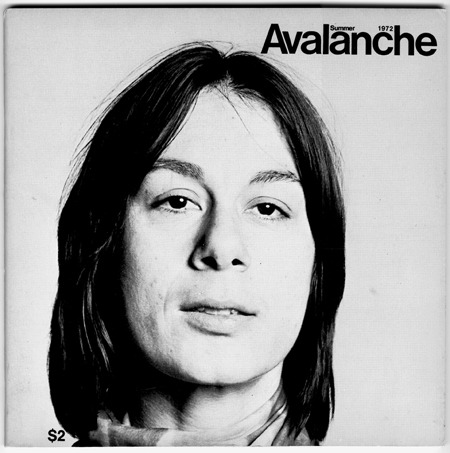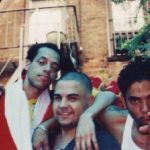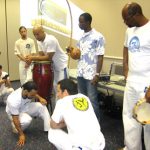The Business of Art: An Interview with Liza Béar by Mary Ann Miller
On the occasion of the recent reprint of Avalanche, 1970-1976, Mary Ann Miller invited co-founder/editor, Liza Béar, to WBAI’s Arts Magazine program. In the following conversation, they discuss Béar’s collaboration with her partner and Avalanche co-founder/editor, Willoughby Sharp; the magazine’s focus on the artist; its process-oriented, straight-to-the-source approach; its championing of the interview format and unique design characteristics; and what it was like to work in the ‘70s and the genesis of the reprint. The transcript of the live broadast has been edited for publication inNYFA Current.
MAM: Liza Béar, welcome back to Arts Magazine. Avalanche—tell us what it was and what it’s going to be.
LB: OK. The best description that my partner, Willoughby Sharp, and I came up with some years ago is that it was a cross between a magazine, an artist book, and an exhibition space in print. Basically, it was devoted to avant-garde art, from the perspective of the artist. Most art magazines at the time, actually all commercial art magazines at the time, gave the critic precedence. I met Willoughby in ’68 when I moved to New York from the London subculture. I was one of the editors of a London underground magazine that published Bob Dylan lyrics and the Situatonist Manifesto. When I met Willoughby, he was curating the Earth Art show, a show of works made in the landscape or of earth materials.
In the late ‘60s and early ‘70s, this new art seemed so fresh, so radical—not only Earth art, but conceptual art, poststudio sculpture, arte povera, performance, video—all kinds of art that stretched the boundaries of art-making and was very sort of freeing in spirit. A lot of it was made outside the studio and could take place on the street, on the page, or out in the desert. The mantra at the time was, “live in your head,” which was the subtitle of a very significant 1969 exhibition called “When Attitudes Become Form.” We felt that if we were going to make a publication that did justice to these artists’ sensibilities, the format should be radical as well. So we used artists’ documents and interviews as the primary modes of expression. Willoughby and I did some interviews together and some separately—at the beginning together because I was younger, newer on the New York scene, and Willoughby was already known as an independent curator, a proselytizer for avant-garde art. We also used lots of black-and-white photography of works in progress. So that was the main editorial content of the magazine. And looking back on the issues now, having worked for 15 or more years as a freelance writer for national newspapers, I can see how extraordinary the Avalanche interviews were. First of all, we weren’t under time pressure because we were our own—
MAM: You were your own bosses.
LB: Yes, we were in charge; we didn’t want to work for anyone else. We weren’t answerable to corporate sponsors because there was no corporate sponsorship then. When we started, our only capital was sweat equity. However, we had the tremendous capital of Willoughby’s knowledge, our enthusiasm, and our complementary energies. Willoughby had been trained as an art historian in the U.S. and Europe, and my university background was in analytic philosophy and editing. And, of course, there was the incredible talent and imagination of the artists, who clearly welcomed a participatory project of this nature. So we didn’t have the pressure of a regular publishing schedule. We tried to come out quarterly, but the best we did was three issues in 1972, numbers 4, 5, and 6.
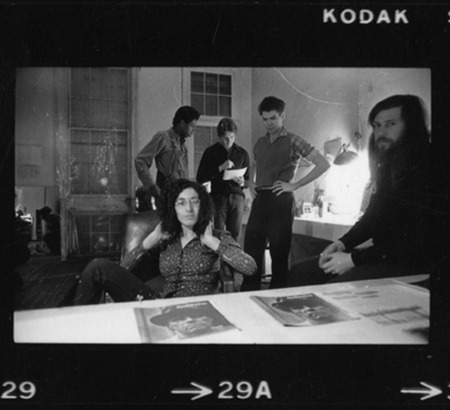
MAM: Well, that’s pretty good. And you were a great combination. Willoughby Sharp being an art historian, and you coming from underground art magazines in London. You must have learned a great deal from him and brought a great deal to Avalanche.
LB: Yes, I think our energies were very well balanced. We were both irreverent of mainstream conventions. We were soul mates: we shared an understanding and an immense curiosity, as well as a direct approach, a resourcefulness, and a can-do attitude. Later critics said, “Well, they didn’t have talent as entrepreneurs…”, but Leo Castelli, for instance, saw us as artists. He said Avalanche was a work of art. We aimed to make a very high-quality publication that would challenge the going orothodoxy of the time, Artforum, which was started in San Francisco. Artforum was heavy on art criticism and reviews, although it had published some theoretical writings by minimalalist artists. Also, we were really concerned with the look of the magazine. And, again, the standard design of art magazines then was columns of type and a single photograph of the finished artwork sort of plunked somewhere in the text. There was no concept of designing a two-page spread, or of designing individual sections, which is how Willoughby, who was the principal designer, approached it. Or of using white space. Or of the magazine as a 3-D object you held in your hand, or of a sort of cinematic progression with the turning page.
MAM: A revelation on each page—
LB: Sort of, yes. We would have very long sections on each artist or sometimes group discussions with a number of artists, for instance Michael Heizer, Dennis Oppenheim, and Robert Smithson in the first issue. But I should mention other artists who were in other issues, too: Vito Acconci, Laurie Anderson, Joseph Beuys, Hanne Darboven, Gordon Matta-Clark, Yvonne Rainer, Keith Sonnier, Jackie Winsor, William Wegman—many many others. We became known also for the now iconic portraits of an artist’s face on the cover. This was considered totally revolutionary in an art magazine, and it was to highlight the fact that the focus was on the artist. Also, the New York art world was very chauvinistic after the ‘50s because the ball was tossed between Paris—
MAM: And New York with the Abstract Expressionists—
LB: Right. I’m a New Yorker now, but I grew up in France and England; Willoughby had made eleven trips in the ‘50s and ‘60s to Europe, and was very cognizant of what was going on in European art. But it wasn’t so much about geography. We had a more cosmopolitan mind-set, an awareness that the radical moves were being made in Europe and Canada as well as in the U.S. We didn’t have that sort of triumphalist approach. In fact, we did several interviews on the road in Amsterdam, England, Germany, Rome, Toronto, and Vancouver, as well as in California, Louisiana, and Texas.
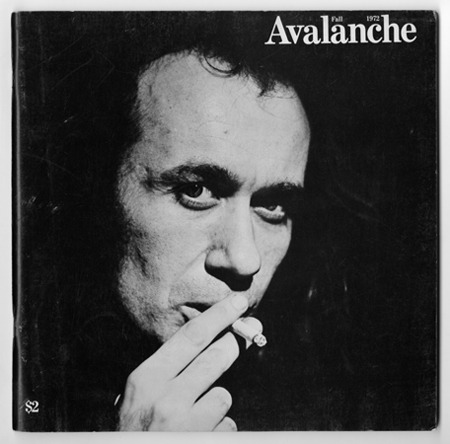
MAM: Avalanche became a collector’s item over the years, didn’t it?
LB: Yes, it did. We put out 13 issues which were really densely packed with information and analysis, including an eight to 12 page news section, much of which was written either by, or in collaboration with, artists; one-liners called “Messages,” and listings of art publications that people sent us that we liked. The publications not listed, I would put on the windowsill outside 93 Grant Street, where we had moved in late 1971, for passersby to pick up; a sort of free library.
To get back to your question—yes, I suppose it did become a collector’s item, and that was partly because it was an incredible resource for scholars of postminimalist art from 1970 to 1976. After that, the art world, the culture, changed dramatically. In the late ‘70s we got the punk aesthetic, a sort of neo-expressionist movement in painting, and the beginnings of the telecommunication revolution. By then Willoughby and I wanted to do our own work. He had already become a video performance artist and I had started to make experimental short films and videos.
We had tried several times to get Avalanche reprinted because there was a demand for it. The issues were very expensive and hard to find. Eventually, we were lucky to find a small not-for-profit organization called Primary Information to do the reprint. They’ve done a magnificent job. Their website is www.primaryinformation.org. People can order a boxed edition, which contains an exact facsimile of the first eight issues, and then the last five issues, which were in newspaper format as a bound volume.
MAM: Unfortunately, Willoughby Sharp didn’t live to see the relaunch of Avalanche.
LB: Yes, that’s the sad thing about this for me, and for Willoughby’s many, many, many friends and the artists he had supported. He died on December 17, 2008. However, I know he’s here in spirit. And you know, the nature of our collaboration was such—Willoughby trusted me implicitly. Just as I trusted him with the design, he trusted me with the editing, anything to do with words, the whole editorial production continuum. And I know that he trusted me to see to every detail and to make sure that the reprint was done as perfectly as it could be.
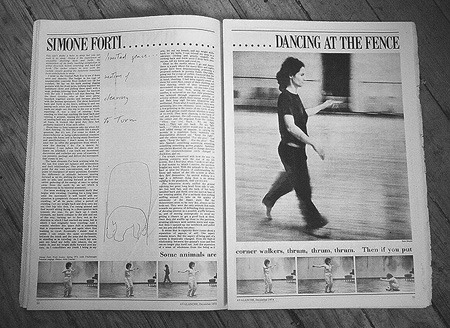
MAM: At the time of Avalanche, Max’s Kansas City was the hub of the art scene. I remember Andy Warhol was right across Park Avenue and you could always find an artist at the bar or in the back or upstairs. It was a place that I went to frequently. And there’s an ad for Max’s on the back of one issue.
LB: Yes.
MAM: “Steak, lobster, chickpeas!” was on the neon sign outside. It was a great place.
LB: Max’s Kansas City was in Gramercy Park three blocks away from East 20th Street, which is where we worked on the first three issues of Avalanche. Contrary to what many people believe, that Avalanche was a SoHo magazine, well, SoHo—
MAM: SoHo didn’t exist then!
LB: No—
MAM: And of course now it’s “So-What.”
LB: Yes. So we hung out at Max’s Kansas City and that’s where the word of mouth spread that an artist magazine was in the making. We would share the big long table at the back with the Warhol people. Warhol, interestingly, published the first issue ofInterview a few months before our first issue came out in October 1970, although we’d been working on it since November 1968. And Interview was obviously devoted to interviews but in a very different sort of style than Avalanche; we weren’t at all celebrity-oriented. Most of the artists in Avalanche hadn’t previously had major gallery or museum shows, so ours was more a process of discovery. Once the word was out, we were flooded with information—phone calls, mail about artists’ projects—and we would follow those leads.
MAM: I remember seeing Philip Glass in one of the issues—beautiful. Even the ad for his record didn’t look like an ad at all.
LB: Right, well, the Avalanche ads were special. Unlike art magazines today, which scatter ads throughout the book and charge more for right-hand pages, our ads were wrapped front and back so that they wouldn’t interfere with the editorial content. This may sound idealistic, but we would do our editorial content first and then we would go after the ads. So, for instance, for the very first issue we created the layout spreads, which we did on our own with a couple of artists helping us in a barn in New Paltz, NY. And then we took the layouts in a big black portfolio uptown—because there was no downtown then—and we showed them to 30 galleries. Leo Castelli, Ileana Sonnabend, Paula Cooper, even Parke-Bernet the auction house—28 of them took out ads. We’d sent out a subscription flier, so we had some money from subscriptions as well…But even so we weren’t able to make it as a private enterprise. People told us about the CCLM—Coordinating Council of Literary Magazines—you can apply for a grant . They gave us the biggest grant they’d ever given to a little magazine—we were called a little magazine because our circulation was 5,000, which is not that small. But to get back to your question—Mickey Ruskin, the owner of Max’s Kansas City, liked Avalanche, so he would trade artwork for meals. Or trade advertising space. The ad that I showed you is very poignant. On one side is a hand-drawn map of the United States with all the states drawn by Robert Smithson, who was killed a few days later in a plane crash on the way to the site of Amarillo Ramp and whose photograph is—
MAM: On the cover—which issue is that?
LB: Avalanche No. 8, Summer/Fall 1973 issue—
MAM: I see, and that was done on a napkin, right?
LB: Well, actually, on Max’s wine list. Advertisers would say, “We don’t want to run our regular ad, let’s do something different.” You know, their creative juices were stimulated, so we probably brainstormed. And Smithson had given me this drawing to show me where he was going, and maybe I suggested it to Mickey Ruskin as an ad.
MAM: Right, well it’s a great ad. Do you still have the original wine list?
LB: No, sorry. In the ‘90s I had to sell it to raise money to pay my lawyer to save my loft .
MAM: Well, it was a wonderful time. A very creative time. And Avalanche and you and Willoughby were a part of it. And now it’s back!
LB: Can I just raise one question?
MAM: Absolutely.
LB: To me it’s absolutely fascinating. I’ve checked the PDFs online for every single issue, and I think that’s 1,016 pages. I’ve rediscovered a lot of the material, a lot of the interviews I hadn’t read for a long time, particularly Willoughby’s. But the reprint is coming out at a time when information-delivery systems have expanded beyond all recognition. Remember, this was a pre-digital publication, so information of this nature was at such a premium. Now anyone can punch in a keyword for any of the artists and find information, or misinformation, misquotes, or whatever. I’m really curious to see how the reprint edition of Avalanche will fare, you know, in a world that’s inundated with information, and whether it will be valued the way it was at the time.
MAM: Well, let’s hope so. Thank you for joining us, Liza, on Arts Magazine.
Liza Béar is a New York-based writer and filmmaker. After the publication of Avalanche, she was a founding member of Bomb and Collaborative Projects. Her experimental films and videos have been screened at the Museum of Modern Art, the Edinburgh International Film Festival, the São Paolo Art Biennial, the Festival of the Other Avant-Garde and other international venues. In 1990 she received a NYFA Fellowship in Creative Non-Fiction for her short stories and in 1994 an Edward Albee Writers Fellowship. She is the author of Beyond the Frame: Dialogues with World Filmmakers(Praeger, 2007), a collection of interviews with 55 filmmakers from 23 countries.

